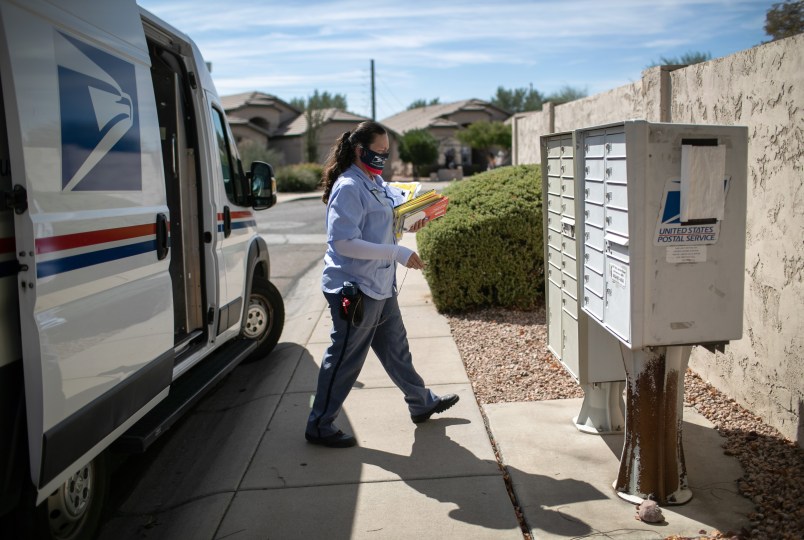Postmaster General Louis DeJoy smiled to his web camera Tuesday as he heralded a new era for the United States Postal Service, one marked most prominently by … slower and more expensive mail.
That was hardly all DeJoy and several other Postal Service executives discussed Tuesday in his much-anticipated rollout of a 10-year plan. After all, the Republican megadonor and former logistics executive said, USPS has a lot of legwork to do if it wants to pursue a “self-help growth strategy” and reverse years of losses.
But the changes to pricing and service standards, previewed in media reports in recent weeks, have spooked USPS customers and swelled anger at a Postal Service leader that many see as a vestige of the Trump years.
DeJoy, for his part, tried to calm fears and put on a brave face Tuesday, stressing “financial sustainability” and “service excellence.”
“For perspective, this is a very positive vision, particularly considering our current position as an organization,” he said during Tuesday’s Zoom press event.
A half-hour later, though, the service’s chief financial officer, Joseph Corbett, said the plan couldn’t tolerate any meddlesome substantial delays or setbacks.
“If we encounter roadblocks with any of the major elements, we quickly get into negative territory and may face annual losses for the coming decade,” Corbett said.
Despite the months of hype over the proposal, details are still relatively limited: “Delivering for America,” as the plan is branded, takes up all of 58 pages. And on Tuesday’s call, DeJoy wouldn’t say which products would see price hikes, nor how much those hikes would be.
“We are not in a position, right now, to identify exactly how much a first-class stamp will go up,” DeJoy said in response to a question about pricing. He said mail would still cost “nowhere near” what it does in several other countries mentioned in the report.
One change DeJoy did articulate was a changed service standard for first-class mail, up from the current 1-3 day standard.
Going forward, long-distance first class mail standards will be five days, or six days for off-shore destinations. USPS executives tried to soften the blow.
“Over 70% of first-class mail would still be delivered within 1-3 days,” Kristin Seaver, chief retail and delivery officer, said of the new benchmark.
Much of the change to the five-day standard comes with mail delivery to the “fringes” of the network, such as coast-to-coast mail, Seaver said later. The wider delivery window for long-distance mail comes in part from a shift away from air travel, which the USPS says is “which is costly and unreliable,” to ground transport.
Slide from ongoing presentation on Postmaster General Louis DeJoy's 10-year plan for the USPS. Talking about "adjusting service standards." In other words, long-distance mail will take longer, but USPS asserts it will be more reliable: pic.twitter.com/pMD2RF7HXT
— Matt Shuham (@mattshuham) March 23, 2021
The changed delivery standards, plans for which were previously reported by the Washington Post, have met some resistance in Congress.
“It sounds like your solution to the problems you’ve identified is to surrender,” Rep. Jamie Raskin (D-MD) told DeJoy in one hearing last month, referring to news that the Postal Service would give itself more time to deliver mail.
“The standards have not been met,” DeJoy replied, adding later in the hearing: “Does it make a difference if it’s an extra day to get a letter? Because something has to change.”
Some parts of DeJoy’s vision have been embraced by both sides of the aisle, such as a request that Congress eliminate its mandate that the Postal Service pre-fund the health care benefits for retirees, a legislative requirement that has added billions of dollars in debt to the USPS books over the years.
The plan also hints at the possibility of transitioning fully to eclectic vehicles by 2035 — “with the right level of Congressional support.” Though the Postal Service recently announced that it would be acquiring a new fleet of vehicles, they are currently slated to be mostly powered by fossil fuels.
“We really don’t have the capital to invest in something that’s more expensive than combustion engines right now,” Corbett told reporters.
Hanging over the press event was the reality that President Joe Biden, if he wanted to, could rid himself of DeJoy and the Postal Service Board of Governors that picked him: Biden recently nominated three people to the service’s Board of Governors, which could form a majority needed to can DeJoy — except that the board chair, Democrat Ron Bloom, has backed the postmaster general. Dozens of Democrats have called on Biden to simply replace the board in its entirety; all current members were nominated by Trump.
As the press conference ended Tuesday, DeJoy passed the mic to Bloom for some closing thoughts.
“I hope you see the amount of work that’s gone into this,” Bloom told reporters of the plan. “This is an organization-wide effort.”
“I hope that the American people, that the Congress, that all of the people who depend on the Postal Service can work with us together in the period ahead as we restore this amazing American treasure,” he added.







When will DeJoy be fired?
Inside DeJoy’s brain:
Does it involve Leavenworth?
(How about a 20-to-Life plan?)
I know DeJoy isn’t a direct appointment, so apparently Biden can’t just fire him. But I sure hope Biden is doing something behind the scenes to get rid of him. DeJoy is a menace. He has a Trumpist political philosophy that mail-in voting is bad, so he’s going to do everything he can to make that harder. And if regular mail suffers as well, so be it.
Literally trying to kill the USPS.
In a time when people get pissed off if their Amazon package takes more than two hours to deliver, somehow it’s acceptable for a letter to take a week to cross town???